英语认知语义学试题
- 格式:doc
- 大小:19.50 KB
- 文档页数:1
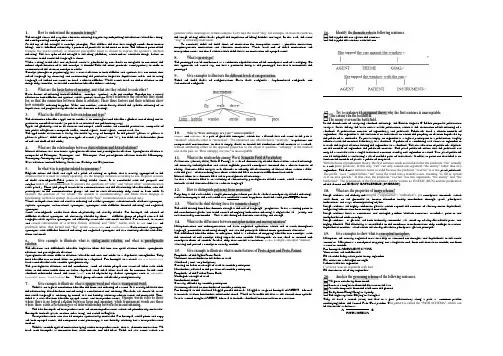
1.How to understand the semantic triangle?The triangle shows the way that semantic meaning happens by interpreting the relations between a thing, the corresponding concept and word.At the top of the triangle is concept (thought). This reflects the fact that languge comes from human beings, and is therefore ultimately a product of processes in the mind or brain. The leftmost point of the triangle, the word (symbol), is whatever perceptible token is chosen to express the speaker’s intented meaning. The last apex of the triangle is the thing (referent), which means whatever things, events or situations in the world the language is about.When a thing in the real and objective world is perceived by our senses or imagined in our mind, the mental representation of it, the concept, is formed.Then the mind produces word(symbol) in order to communicate the abstract concept to others.Concept (thought or psychology) has a causal relation to both referent and symbol: it is our minds that create language by choosing and constructing the particular linguistic expressions used; and in using language we intend our words to have a certain referent. While words have no direct relation to the things they stand for, so that the connection between them is arbitary.2.What are the basic factor of meaning, and what are they related to each other?Basic factors of meaning include referent,concept,symbol,user and context. Concept has a causal relation to both referent and symbol, while symbols have no direct relation to the referents they stand for, so that the connection between them is arbitary. These three factors and their relations show how semantic meaning happens. Users and contexts, which finally decide the specific meaning of an expression, are pragmatically related to the semantic meanings.3.What is the differences between token and type?The distinction between a type and its tokens is an ontological one beween a general sort of thing and its particular concrete instances (to put it in an intuitive and preliminary way).Types are generally said to be abstract and unique, while tokens are concrete particulars, composed of ink, pixels of light on a computer screen, smoke signals, hand signals, sound wave, etc.The type/token distinction is easily illustrated by way of example. In the phrase "yellow is yellow is yellow is yellow", there are only two types of words ("yellow" and "is"), but there are seven tokens (four of one and three of the other).4.What are the relationships between class relations and lexical relations?Lexical relations has two kinds: syntagmatic relation and paradigmatic relation. Syntagmatic relation is composed of Phlonyms, Tautonyms and Xenonyms. And paradigmatic relation includes Meronymy, Taxonymy, Antonymy and Synoymy.Class relations include Identity, Inclusion, Overlap and Disjunction5.In what way is register related to synonymy ?Register means the level and style of a piece of writing or speech, that is usually appropriate to the situation that it is used in; simply speaking, it’s the languge variation according to use. Register consists of three subcategories:Field (what is being talked about, It is concerned with the purpose and subject-takes place.), Tenor (the people involved in communication and the relationship between them, who the participants communication groups are and in what relationship they stand to each other. It answers the question of “to whom” the speaker is communicating.) and Mode (how languge is functioning, written or spoken. It is concerned with “how” communication is carried out.).Words or expressions that are close in meaning are called synonyms, which includes dialectal synonyms, stylistic synonyms, collocational synonyms, synonyms with different emotive meaning and cognitive synonyms.Some subcategories under each term respectively are closely related. For example, the choice of different dialectal synonyms are obviously decided by tenor --- different group of people who use the languge; while stylistic synomyms are definitely associated with mode and field. For instance, in an oral and casual conversation or a written fiction, informal and “little” words, such as ask and fire are preferred rather than formal and “big” words interrogate and conflagration.Collocational synonyms, synonyms with different emotive meaning and cognitive synonyms are also similarly related with field, tenor and mode.6.Give example to illustrate what is syntag-matic relation, and what is paradigmatic relation.The relations and differences between linguistic items fall into two quite distinct kinds: syntagmatic relations and paradigmatic relations.Syntagmatic relations refer to relations between one unit and others in a sequential arrangement. They hold between two or more items co-present in a sequence. For example, in a clause she is a lovely girl, each word relatetd with another syntagmatically.The paradigmatic relations are the connexions, some of which people can associate them with other items in the mind rather than on linear sequence since these items have sth. In common. In the same sentence mentioned above, the word lovely can be replaced by several synonyms such as adorable, beautiful, naive, good-looking etc.. These group of words are related paradigmatically.7.Give example to illustrate what is opaque word and what is transparent word.There is no logical connection between the form and meaning of a word. It is usually believed that the relationship between form and meaning is conventional and arbitrary. However, we should be aware that while language is arbitrary by nature, it is not entirely arbitrary; certain words are motivated. Thus, there is a classification between opaque words and transparent words. Opaque words refer to those where there is no logical relation between form and meaning; while transparent words are those where there exists a certain degree of interrelationship between form and meaning.The best examples of transparent words are onomatopoeic words which are phonetically motivated. Examples include splash, cuckoo, mew, bang, and cackle in English.Transparent words can also be morpho-syntactically motivated. For example, while photo and copy are both opaque words, the compound word photocopy is not entirely arbitrary but a transparent word instead.There is another type of motivation lying within transparent words, that is, semantic motivation. We have such examples as mountain foot, river mouth, and tree head. There are also words which can generate other meanings in certain contexts. Let’s take the word “dog” for example. In western countries,the image of dog often leaves people the impresion of being faithful and loyal. In this case, the word“dog” is culturally motivated.To conclude, there are three kinds of motivation for transparent words –phonetic motivation,morphosyntactic motivation and semantic motivation. Words have one of these motivations aretransparent words and those within which there exists no motivation are opaque words.8.What is prototype?The prototype can be understood as a schematic representation of the conceptual core of a category. Onthis approach, we would say, not that a particular entity is the prototype, but that it instantiates theprototype9.Give examples to illustrate the different levels of categorization.There are three levels of categorization: Basic level categories,Superordinate categories andSubordinate categories.10.Why is “How unhappy are you?” unacceptable?Happy and unhappy is a pair of gradable antonyms, which has a feature that one word in the pair is“marked” while the other is “unmarked”. The unmarked one often behaves “neutrally” i n questions andcomparative constructions, in that it simply serves to invoke the dimension of the contrast as a whole,without attributing either of the opposed properties to the object it qualifies. “unhappy” is the markedone in the pair, so “How unhappy are you?”is unacceptable.11.What is the relationship among Word, Semantic Field &VocabularyA Semantic (lexical) field( Trier & Porzig), is a set of semantically related lexical items whose meaningsare mutually interdependent and which together provide conceptual structure for a certain domain ofreality. Semantic field analysis uses features to identify the relationship of lexical items within a field,with the goal of discovering how terms within the field or domain differ from each other.Lexical items in a semantic field are in paradigmatic relationships.So that a semantic field is an assembly of semantically paradigmatic-related words, while a vocabularyincludes all the semantic fields in a certain language.12.How to distinguish polysemy from monosemy?Polysemy is the case where a single phonological form possesses several conceptually related meanings,while homonymy is the case where two unrelated words happen to share the same phonological form.13.What is the chief driving force for semantic change?The chief driving force for semantic change is the use of language / pragmatics. It has a starting point inthe conventional given, but in the course of ongoing interaction meaning is negotiated, ie. jointly andcollaboratively constructed ... This is the setting of semantic variability and change14.What is the differences between metaphorization and metonymization?Metaphorization and metonymization are basic cognitive operations which are at work throughoutlanguage, prominent in meaning change, and also the principles behind much synchronic semantics.The difference between them: in metaphor, there is a relation of mapping between two concepts, withthe structure of one concept being imposed onto another. Metonymies do not serve to stucture oneconcept in terms of another. Instead, they draw on the associations within a single conceptal “domain”,allowing one part of a concept to convey another.15.Give example to illustrate what is main features of Proto-Agent and Proto-Patient.Properties of the Agent Proto-Role:V olitional involvement in the event or stateSentience ( and / or perception)Causing an event or change of state in another participantMovement ( relative to the position of another participant)Properties of the Patient Proto-Role:Undergoes change of stateIncremental themeCausally affected by another participantStationary relative to movement of another participantFor example, in the sentence Maggie pruned the roses. Maggie is an good example of AGENT , becauseit involves all four entailments mentioned above. While in Joan felt the heat as the aircraft door opened.Joan is a more marginal AGENT, because it includes sentience but not volition or causation.16.Identify the thematic roles in following sentences.☐She tapped the can against the window.☐She tapped the window with the can.-17.Try to explain with argument theory why the first sentence is unacceptable.☐*The enemy ran the battlefield.☐The enemy overran the battlefield.In the framework of analyzing sentence meanings, the British linguist G. Leech proposed predicationanalysis. In his theory, the basic unit is called predication, which is the abstraction of the meaning of asentence. A predication consists of argument(s) and predicate. Predicates have a certain number ofarguments. An argument is the individual or individuals to which the property or relation expressed bythe predicate is attributed. To put it simply, an argument is a logical participant in a predication, largelyidentical with the nominal element(s) in a sentence. A predicate is something said about an argument orit states the logical relation linking the arguments in a sentence. The classification of predicates dependson the number of arguments the predicate contains. One-place predicate means that the predicate canonly be associated with a single individual constant, namely one argument at a time. Two-place predicatecan be interpreted as indicating a set of ordered pairs of individuals. It needs to point out that there is nolimit on the number of places a predicate may have.With the basis of predication theory, the first sentence reads as invalid in that the predicate “ran” actuallyis a one-place predicate. In this way, “ran” can only contain one argument “the enemy” rather than twoarguments. The seco nd sentence reads as valid because the predicate “overran” is a two-place predicate.The prefix “over-” added before “ran” turns the word into a transitive one, meaning “to fill or spreadover an area quickly.” In this case, the predicate “overran” has two arguments, “the enemy” and “thebattlefield.” The predication of the first sentence can be written as: ENEMY (RUN) and the predicationof the second one ENEMY, BA TTLEFIELD (OVERRUN).18.What are the properties of image schema?Image schemas are directly me aningful (“experiential”/ “embodied”), pre-conceptual structures, whicharise from, or are grounded in, human recurrent bodily movements through space, perceptualinteractions and ways of manipulating objects.Image schemas are highly schematic gestalts which capture the contours of sensory-motor experience,integrating information from multiple modalities.Image schemas exist as continuous and analogue patterns beneath conscious awareness, prior to andindependent of other concepts.Image schemas , as gestalts, are both internally structured , i.e., made up of very few related parts, andhighly flexible. The flexibility is manifested in the numerous transformations they undergo in variousexperiential contexts, all of which are closely related to perceptual /gestalt principles.19.Give examples to show what is conceptual metaphor.Metaphors are actually cognitive tools that help us structure our thoughts and experiences in the worldaround us. Metaphor is a conceptual mapping, not a linguistic one, from one domain to another, not froma word to another.For example: ARGUMENT IS WARYour claims are indefensible.He attacked every weak point in my argument.His criticisms were right on target.I demolished his argument.I’ve never won an argument with him.He shot down all of my arguments.20.Analyze the governing schema of the following sentences.☐We go to university from home.☐Look at a long train from the first car to the last.☐A water drop rolls from the table onto the ground.☐To fly from Hong Kong to Sydney.☐The highway links Beijing to Shanghai.They all have a source (start) and lead to a goal (destination) along a path--a common patternunderlying them--the Source-Path-Goal pattern. T his pattern is called the “PA TH SCHEMA", which canbe illustrated as follows:A BPA TH SCHEMA。
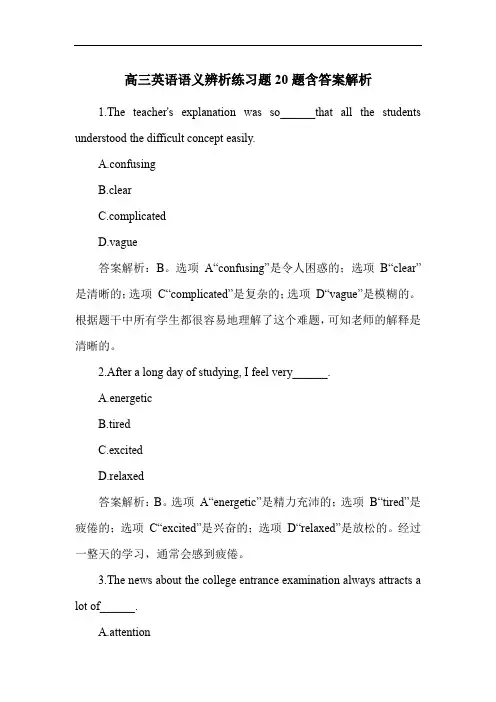
高三英语语义辨析练习题20题含答案解析1.The teacher's explanation was so______that all the students understood the difficult concept easily.A.confusingB.clearplicatedD.vague答案解析:B。
选项A“confusing”是令人困惑的;选项B“clear”是清晰的;选项C“complicated”是复杂的;选项D“vague”是模糊的。
根据题干中所有学生都很容易地理解了这个难题,可知老师的解释是清晰的。
2.After a long day of studying, I feel very______.A.energeticB.tiredC.excitedD.relaxed答案解析:B。
选项A“energetic”是精力充沛的;选项B“tired”是疲倦的;选项C“excited”是兴奋的;选项D“relaxed”是放松的。
经过一整天的学习,通常会感到疲倦。
3.The news about the college entrance examination always attracts a lot of______.A.attentionB.interestC.curiosityD.concern答案解析:A。
选项A“attention”是注意力;选项B“interest”是兴趣;选项C“curiosity”是好奇心;选项D“concern”是关心。
新闻通常会吸引注意力。
4.The math problem is extremely______.A.difficultB.easyC.simpleD.pleasant答案解析:A。
选项A“difficult”是困难的;选项B“easy”是容易的;选项C“simple”是简单的;选项D“pleasant”是令人愉快的。
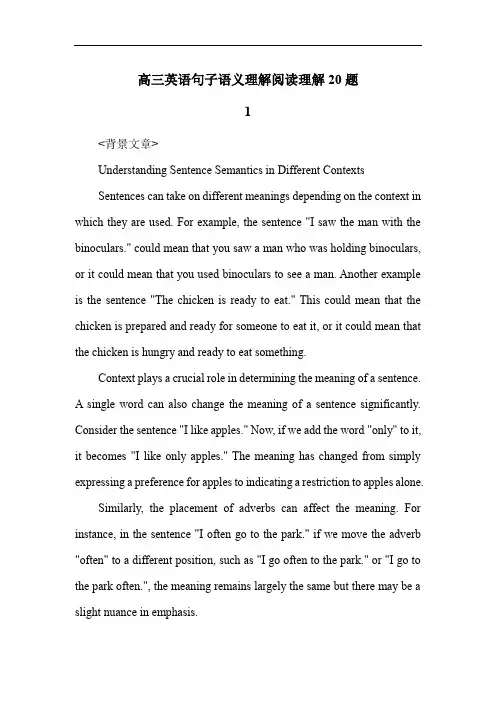
高三英语句子语义理解阅读理解20题1<背景文章>Understanding Sentence Semantics in Different ContextsSentences can take on different meanings depending on the context in which they are used. For example, the sentence "I saw the man with the binoculars." could mean that you saw a man who was holding binoculars, or it could mean that you used binoculars to see a man. Another example is the sentence "The chicken is ready to eat." This could mean that the chicken is prepared and ready for someone to eat it, or it could mean that the chicken is hungry and ready to eat something.Context plays a crucial role in determining the meaning of a sentence.A single word can also change the meaning of a sentence significantly. Consider the sentence "I like apples." Now, if we add the word "only" to it, it becomes "I like only apples." The meaning has changed from simply expressing a preference for apples to indicating a restriction to apples alone.Similarly, the placement of adverbs can affect the meaning. For instance, in the sentence "I often go to the park." if we move the adverb "often" to a different position, such as "I go often to the park." or "I go to the park often.", the meaning remains largely the same but there may be a slight nuance in emphasis.Understanding these nuances in sentence semantics is essential for effective communication and accurate interpretation of written and spoken language.1. The sentence "I saw the man with the binoculars." could mean ___.A. I saw a man and he had binoculars.B. I used binoculars to see a man.C. Both A and B.D. Neither A nor B.答案:C。
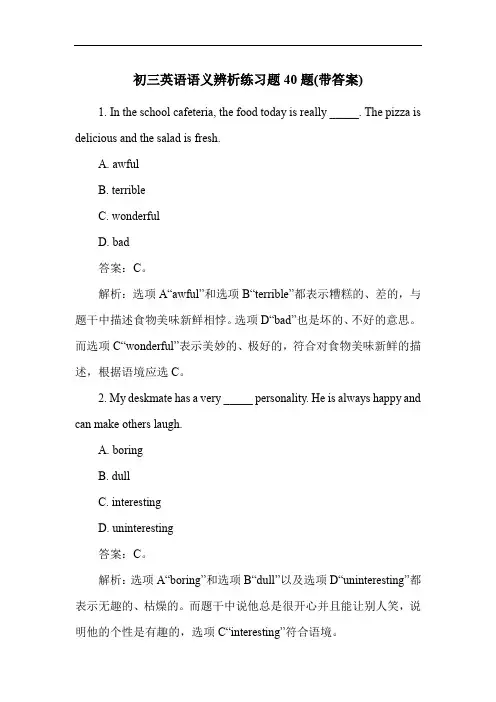
初三英语语义辨析练习题40题(带答案)1. In the school cafeteria, the food today is really _____. The pizza is delicious and the salad is fresh.A. awfulB. terribleC. wonderfulD. bad答案:C。
解析:选项A“awful”和选项B“terrible”都表示糟糕的、差的,与题干中描述食物美味新鲜相悖。
选项D“bad”也是坏的、不好的意思。
而选项C“wonderful”表示美妙的、极好的,符合对食物美味新鲜的描述,根据语境应选C。
2. My deskmate has a very _____ personality. He is always happy and can make others laugh.A. boringB. dullC. interestingD. uninteresting答案:C。
解析:选项A“boring”和选项B“dull”以及选项D“uninteresting”都表示无趣的、枯燥的。
而题干中说他总是很开心并且能让别人笑,说明他的个性是有趣的,选项C“interesting”符合语境。
3. There are so many _____ in the library. We can choose whatever we like to read.A. rulesB. magazinesC. desksD. librarians答案:B。
解析:选项A“rules”是规则的意思,图书馆有规则但这与能选择阅读的东西无关。
选项C“desks”是桌子,与阅读内容无关。
选项D“librarians”是图书管理员,也不是用来阅读的。
选项B“magazines”杂志,在图书馆里有很多杂志可以供选择阅读,符合语境。
4. The school uniform of our school is very _____. It is comfortable and looks nice.A. uglyB. beautifulC. practicalD. fashionable答案:C。
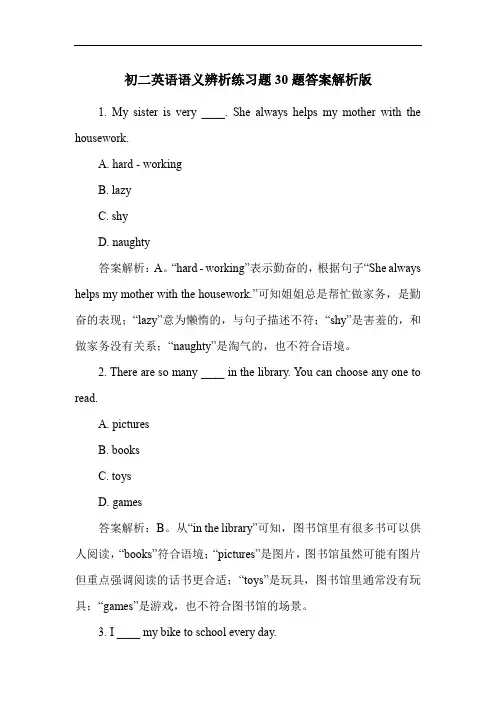
初二英语语义辨析练习题30题答案解析版1. My sister is very ____. She always helps my mother with the housework.A. hard - workingB. lazyC. shyD. naughty答案解析:A。
“hard - working”表示勤奋的,根据句子“She always helps my mother with the housework.”可知姐姐总是帮忙做家务,是勤奋的表现;“lazy”意为懒惰的,与句子描述不符;“shy”是害羞的,和做家务没有关系;“naughty”是淘气的,也不符合语境。
2. There are so many ____ in the library. You can choose any one to read.A. picturesB. booksC. toysD. games答案解析:B。
从“in the library”可知,图书馆里有很多书可以供人阅读,“books”符合语境;“pictures”是图片,图书馆虽然可能有图片但重点强调阅读的话书更合适;“toys”是玩具,图书馆里通常没有玩具;“games”是游戏,也不符合图书馆的场景。
3. I ____ my bike to school every day.A. driveB. rideC. takeD. fly答案解析:B。
“ride a bike”是骑自行车的固定搭配;“drive”通常用于驾驶汽车等交通工具;“take”虽然可以表示乘坐交通工具,但用法为“take a bus / train”等,不与“bike”这样搭配;“fly”是飞,不符合骑自行车上学的语境。
4. The movie is very ____. I want to see it again.A. boringB. interestingC. difficultD. easy答案解析:B。
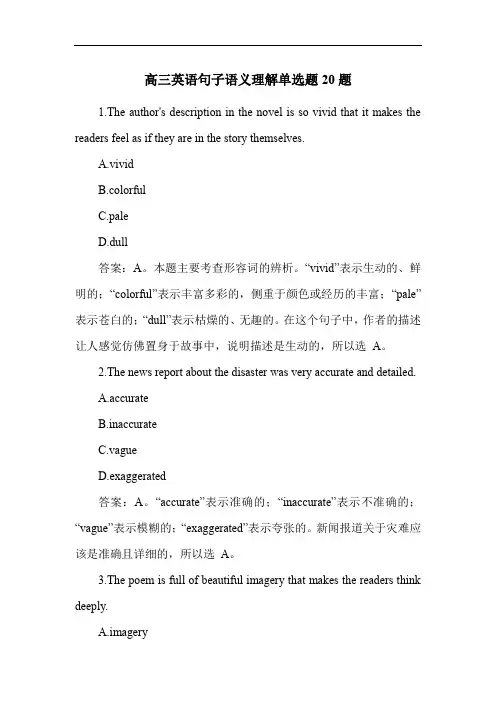
高三英语句子语义理解单选题20题1.The author's description in the novel is so vivid that it makes the readers feel as if they are in the story themselves.A.vividB.colorfulC.paleD.dull答案:A。
本题主要考查形容词的辨析。
“vivid”表示生动的、鲜明的;“colorful”表示丰富多彩的,侧重于颜色或经历的丰富;“pale”表示苍白的;“dull”表示枯燥的、无趣的。
在这个句子中,作者的描述让人感觉仿佛置身于故事中,说明描述是生动的,所以选A。
2.The news report about the disaster was very accurate and detailed.A.accurateB.inaccurateC.vagueD.exaggerated答案:A。
“accurate”表示准确的;“inaccurate”表示不准确的;“vague”表示模糊的;“exaggerated”表示夸张的。
新闻报道关于灾难应该是准确且详细的,所以选A。
3.The poem is full of beautiful imagery that makes the readers think deeply.A.imageryB.storyC.descriptionD.dialogue答案:A。
“imagery”表示意象、形象;“story”表示故事;“description”表示描述;“dialogue”表示对话。
诗中充满的是美丽的意象,能让读者深思,所以选A。
4.The article in the magazine is very informative and useful.rmativeB.boringC.confusingeless答案:A。
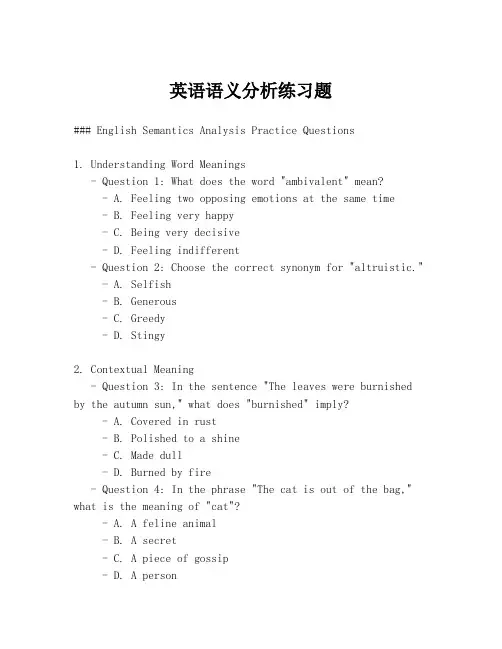
英语语义分析练习题### English Semantics Analysis Practice Questions1. Understanding Word Meanings- Question 1: What does the word "ambivalent" mean?- A. Feeling two opposing emotions at the same time- B. Feeling very happy- C. Being very decisive- D. Feeling indifferent- Question 2: Choose the correct synonym for "altruistic." - A. Selfish- B. Generous- C. Greedy- D. Stingy2. Contextual Meaning- Question 3: In the sentence "The leaves were burnished by the autumn sun," what does "burnished" imply?- A. Covered in rust- B. Polished to a shine- C. Made dull- D. Burned by fire- Question 4: In the phrase "The cat is out of the bag," what is the meaning of "cat"?- A. A feline animal- B. A secret- C. A piece of gossip- D. A person3. Idiomatic Expressions- Question 5: What does the idiom "break the ice" mean? - A. To start a fight- B. To initiate a conversation- C. To stop a conversation abruptly- D. To cool down a heated argument- Question 6: The phrase "spilled the beans" is used to describe which action?- A. Cleaning up a mess- B. Telling a secret- C. Cooking a meal- D. Planting seeds4. Word Relationships- Question 7: Which word is the antonym of "extrovert"? - A. Introvert- B. Extroverted- C. Ambiverted- D. Outgoing- Question 8: The word "antidote" is related to which of the following?- A. A poison- B. A cure- C. A symptom- D. A disease5. Syntactic Analysis- Question 9: In the sentence "The dog chased the cat up the tree," what is the direct object of the verb "chased"? - A. The dog- B. The cat- C. Up- D. The tree- Question 10: Identify the subject of the sentence "Running in the park is good for health."- A. The park- B. Running- C. Health- D. Good6. Semantic Roles- Question 11: In the sentence "She baked a cake for her friend," what is the semantic role of "her friend"?- A. Agent- B. Patient- C. Recipient- D. Instrument- Question 12: In the sentence "The storm destroyed the house," what is the semantic role of "the storm"?- A. Theme- B. Agent- C. Patient- D. Location7. Pragmatics- Question 13: If someone says, "Can you pass the salt?" at the dinner table, what is the implied meaning?- A. They are asking if you are capable of passing the salt.- B. They are asking for the salt to be passed to them. - C. They are commenting on the quality of the food.- D. They are asking if the salt is available.- Question 14: What is the implied meaning of the statement "You look nice today"?- A. The person's appearance is different from usual. - B. The person is dressed inappropriately.- C. The speaker is complimenting the person's appearance.- D. The person is not usually nice.8. Pronoun Reference- Question 15: In the sentence "John told Mary that he would help her with the project," what does the pronoun "he" refer to?- A. John- B. Mary- C. The project- D. The sentence does not provide enough information.9. Ambiguity Resolution- Question 16: The sentence "I saw the man with the telescope" can be ambiguous. What are two possible interpretations?- A. The man had a telescope, and I saw him.- B. I used a telescope to。
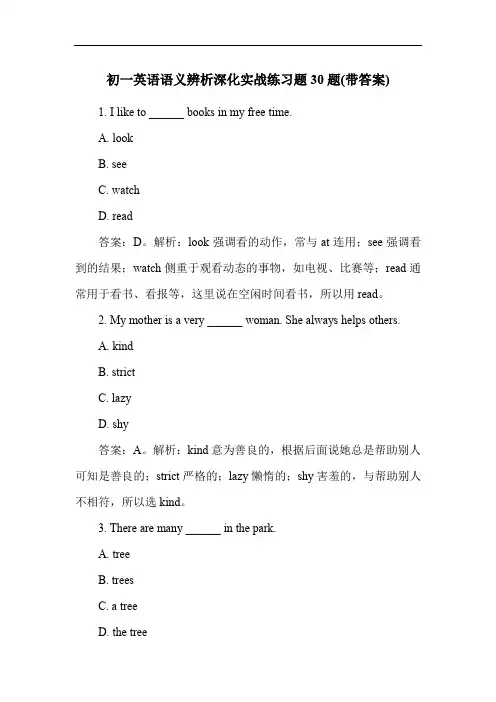
初一英语语义辨析深化实战练习题30题(带答案)1. I like to ______ books in my free time.A. lookB. seeC. watchD. read答案:D。
解析:look强调看的动作,常与at连用;see强调看到的结果;watch侧重于观看动态的事物,如电视、比赛等;read通常用于看书、看报等,这里说在空闲时间看书,所以用read。
2. My mother is a very ______ woman. She always helps others.A. kindB. strictC. lazyD. shy答案:A。
解析:kind意为善良的,根据后面说她总是帮助别人可知是善良的;strict严格的;lazy懒惰的;shy害羞的,与帮助别人不相符,所以选kind。
3. There are many ______ in the park.A. treeB. treesC. a treeD. the tree答案:B。
解析:many后接可数名词复数,tree的复数形式是trees;a tree是单数形式,the tree表示特指某一棵树,这里说公园里有很多树,所以是trees。
4. I ______ my homework at seven o'clock every evening.A. doB. makeC. haveD. take答案:A。
解析:do one's homework是固定搭配,表示做家庭作业;make制作;have有;take拿、取,所以选do。
5. My hobby is ______. I like drawing pictures.A. singB. dancingC. paintingD. reading答案:C。
解析:根据后面说喜欢画画可知爱好是绘画;sing唱歌;dancing跳舞;reading阅读,都不符合画画的意思,所以是painting。
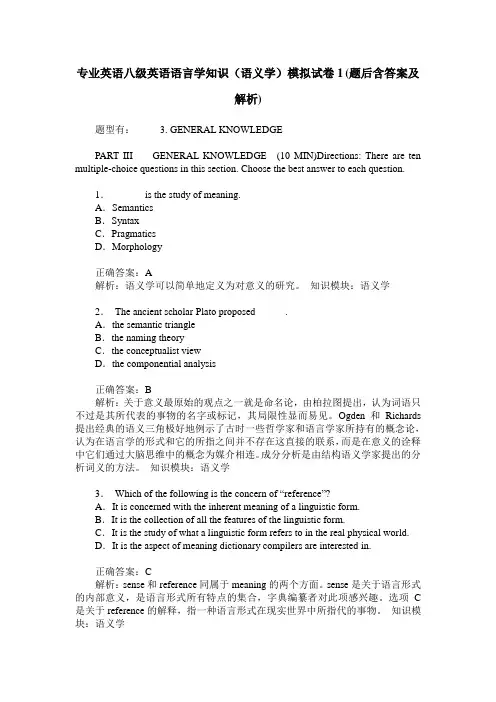
专业英语八级英语语言学知识(语义学)模拟试卷1(题后含答案及解析)题型有: 3. GENERAL KNOWLEDGEPART III GENERAL KNOWLEDGE (10 MIN)Directions: There are ten multiple-choice questions in this section. Choose the best answer to each question.1.______is the study of meaning.A.SemanticsB.SyntaxC.PragmaticsD.Morphology正确答案:A解析:语义学可以简单地定义为对意义的研究。
知识模块:语义学2.The ancient scholar Plato proposed______.A.the semantic triangleB.the naming theoryC.the conceptualist viewD.the componential analysis正确答案:B解析:关于意义最原始的观点之一就是命名论,由柏拉图提出,认为词语只不过是其所代表的事物的名字或标记,其局限性显而易见。
Ogden和Richards 提出经典的语义三角极好地例示了古时一些哲学家和语言学家所持有的概念论,认为在语言学的形式和它的所指之间并不存在这直接的联系,而是在意义的诠释中它们通过大脑思维中的概念为媒介相连。
成分分析是由结构语义学家提出的分析词义的方法。
知识模块:语义学3.Which of the following is the concern of “reference”?A.It is concerned with the inherent meaning of a linguistic form.B.It is the collection of all the features of the linguistic form.C.It is the study of what a linguistic form refers to in the real physical world.D.It is the aspect of meaning dictionary compilers are interested in.正确答案:C解析:sense和reference同属于meaning的两个方面。
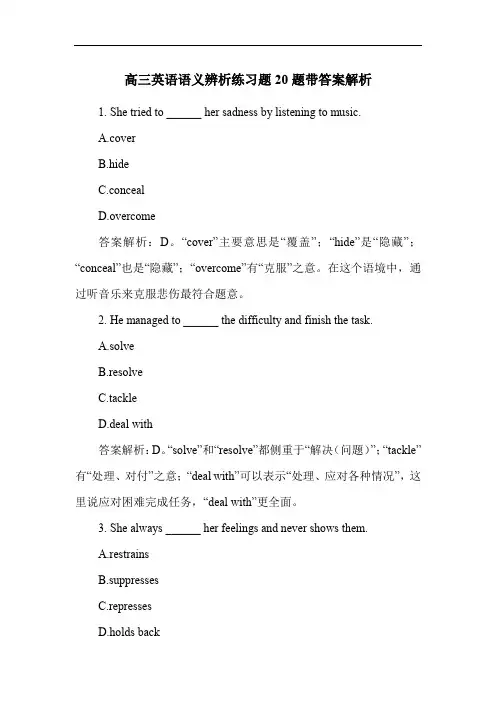
高三英语语义辨析练习题20题带答案解析1. She tried to ______ her sadness by listening to music.A.coverB.hideC.concealD.overcome答案解析:D。
“cover”主要意思是“覆盖”;“hide”是“隐藏”;“conceal”也是“隐藏”;“overcome”有“克服”之意。
在这个语境中,通过听音乐来克服悲伤最符合题意。
2. He managed to ______ the difficulty and finish the task.A.solveB.resolveC.tackleD.deal with答案解析:D。
“solve”和“resolve”都侧重于“解决( 问题)”;“tackle”有“处理、对付”之意;“deal with”可以表示“处理、应对各种情况”,这里说应对困难完成任务,“deal with”更全面。
3. She always ______ her feelings and never shows them.A.restrainsB.suppressesC.repressesD.holds back答案解析:B。
“restrains”主要是“抑制、约束( 行为等)”;“suppresses”指“压制、忍住( 感情等)”;“represses”也有“压抑( 情感等)”的意思;“holds back”有“阻止、抑制”等含义,这里强调忍住感情不表现出来,“suppresses”最合适。
4. He ______ to understand what she was saying.A.struggledB.triedC.attemptedD.made efforts答案解析:A。
“tried”和“attempted”都是“尝试”;“made efforts”是“努力”;“struggled”有“挣扎、艰难地做某事”之意,这里表示努力去理解她的话很费劲,“struggled”更能体现这种艰难。
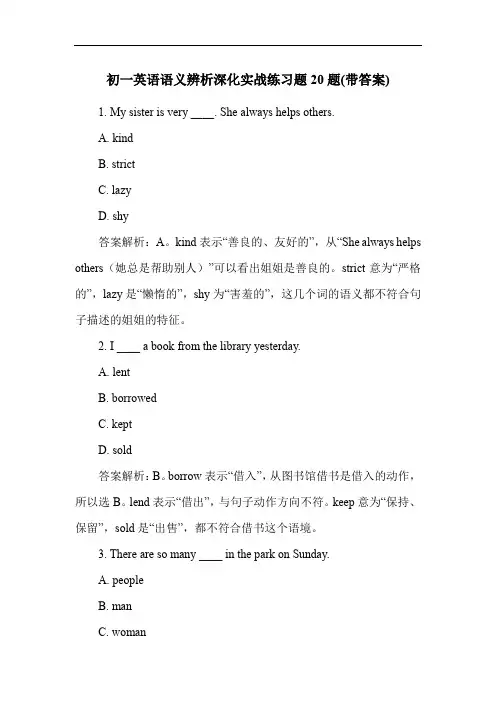
初一英语语义辨析深化实战练习题20题(带答案)1. My sister is very ____. She always helps others.A. kindB. strictC. lazyD. shy答案解析:A。
kind表示“善良的、友好的”,从“She always helps others(她总是帮助别人)”可以看出姐姐是善良的。
strict意为“严格的”,lazy是“懒惰的”,shy为“害羞的”,这几个词的语义都不符合句子描述的姐姐的特征。
2. I ____ a book from the library yesterday.A. lentB. borrowedC. keptD. sold答案解析:B。
borrow表示“借入”,从图书馆借书是借入的动作,所以选B。
lend表示“借出”,与句子动作方向不符。
keep意为“保持、保留”,sold是“出售”,都不符合借书这个语境。
3. There are so many ____ in the park on Sunday.A. peopleB. manC. womanD. child答案解析:A。
people是集合名词,本身表示复数概念,“公园里有很多人”要用people。
man(男人)、woman(女人)、child(孩子)都是单数形式,不符合句子中“many(许多)”的要求。
4. The music sounds very ____. I like it very much.A. wellB. goodC. badD. badly答案解析:B。
sound是系动词,后面接形容词作表语,good是形容词,表示“好的”,音乐听起来很好听,所以选B。
well作形容词时表示“健康的”,作副词时表示“好地”;bad是“坏的”;badly是副词“坏地、糟糕地”,都不符合句子语义。
5. My father ____ to work by car every day.A. goB. goesC. wentD. going答案解析:B。
高三英语语义辨析练习题20题(答案解析)1. The new policy is expected to ______ the economic development of the region.A. promoteB. preventC. protestD. propose答案解析:A。
本题考查动词词义辨析。
promote有促进、推动之意,新政策预期会推动地区的经济发展,语义相符。
prevent表示阻止,与题意相悖。
protest是抗议的意思,在这里语义不通。
propose是提议、建议,不符合语境。
2. His speech was so ______ that most of the audience fell asleep.A. boringB. boredC. interestingD. interested答案解析:A。
boring表示令人厌烦的,用来形容事物,他的演讲令人厌烦,所以大部分观众都睡着了。
bored是感到厌烦的,用来形容人。
interesting有趣的,与观众睡着的情况不符。
interested感兴趣的,也是形容人的感受,不符合题意。
3. The young man has a ______ for adventure and is always eager to explore new places.A. passionB. fashionC. compassionD. portion答案解析:A。
passion有热情、酷爱之意,这个年轻人对冒险有热情,总是渴望探索新地方。
fashion是时尚,compassion是同情,portion是部分,这三个词在语义上都不符合句子的语境。
4. The company is trying to ______ the cost of production to increase its profit.A. reduceB. produceC. introduceD. deduce答案解析:A。
高三英语句子语义理解单选题20题1.The teacher asked the students to be quiet,but they kept talking_____.A.loudlyB.softlyC.quicklyD.slowly答案:A。
本题考查副词的语义理解。
选项A“loudly”表示大声地,符合学生们在老师要求安静后还在继续说话的情景;选项B“softly”是轻声地,与题目情境不符;选项C“quickly”是快速地,主要强调速度,不适合这里的语境;选项D“slowly”是慢慢地,也不符合语境。
2.In the news report,it was said that the accident happened_____.A.suddenlyB.graduallyC.regularlyD.occasionally答案:A。
本题考查副词的语义理解。
选项A“suddenly”表示突然地,符合意外事故发生的特点;选项B“gradually”是逐渐地,事故一般不会逐渐发生;选项C“regularly”是有规律地,事故通常没有规律;选项D“occasionally”是偶尔地,不能准确描述事故发生的情况。
3.When I met my old friend,we greeted each other_____.A.warmlyB.coldlyC.carelesslyD.angrily答案:A。
本题考查副词的语义理解。
选项A“warmly”表示热情地,老友相见通常会热情打招呼;选项B“coldly”是冷淡地,不符合老友相见的情境;选项C“carelessly”是粗心地,不适合用于打招呼的情境;选项D“angrily”是生气地,也不符合老友相见的情况。
4.The speaker spoke so fast that I could hardly understand him_____.A.clearlyB.quicklyC.slowlyD.loudly答案:A。
高考英语语义辨析深度练习题40题(带答案)1. The ____ of the new technology has greatly changed our way of life.A. inventionB. discoveryC. creationD. finding答案:A。
解析:invention强调创造出以前不存在的东西,通常指发明、创造新的技术、产品等,这里新技术的发明改变了生活方式,符合题意;discovery侧重于发现原本已经存在但不为人知的事物,比如发现新的星球、古迹等;creation更强调创造出具有创造性的作品或成果,如艺术作品等;finding常指调查、研究后的发现结果,多是一些数据、事实等,所以A最恰当。
2. In some Asian cultures, ____ is highly valued and respected.A. seniorityB. superiorityC. priorityD. minority答案:A。
解析:seniority表示资历、年长,在一些亚洲文化中,资历是被高度重视和尊重的;superiority意为优越性、优势,侧重于比较后的优势;priority表示优先、优先权,与题意不符;minority指少数、少数民族,语义完全不同,所以A正确。
3. The government is trying to ____ the gap between the rich and the poor.A. shortenB. narrowC. decreaseD. reduce答案:B。
解析:narrow可表示使变窄、缩小差距等,narrow the gap是固定搭配,表示缩小差距;shorten主要指长度上的缩短;decrease侧重于数量的减少;reduce虽然也有减少的意思,但在表示差距缩小的时候,narrow更常用,所以B合适。
4. With the ____ of modern transportation, people can travel around the world more easily.A. developmentB. progressC. growthD. improvement答案:A。
高三英语句子语义理解练习题20题1.The author's vivid description brings the story to life, making the readers feel as if they are part of it.A.brings the story to deathB.takes the story to lifeC.gives the story to lifeD.puts the story to life答案:C。
本题考查短语“bring...to life”“give...to life”“take...to life”和“put...to life”的区别。
“bring...to life”意为“使……生动起来”;“give...to life”也有“赋予……生命、使……生动”之意;“take...to life”和“put...to life”用法不常见。
A 选项意思错误;B 选项搭配不准确;D 选项搭配不当。
本题考查的语义理解要点是对这些短语的准确理解和运用。
2.The news report was so detailed that it left no stone unturned in covering the event.A.left no stone unturnedB.left some stones unturnedC.left a few stones unturnedD.left many stones unturned答案:A。
“leave no stone unturned”意为“千方百计、不遗余力”。
B、C、D 选项意思不准确,改变了原意。
本题考查的语义理解要点是对这个习语的掌握。
3.She has a talent for painting and can capture the essence of a scene with just a few strokes.A.capture the existence of a sceneB.catch the essence of a sceneC.grab the essence of a sceneD.take the essence of a scene答案:B。
高一英语语义辨析练习题30题1.The students are discussing the plans for their school _____.A.activityB.activitiesC.actionD.actions答案:B。
“activity”表示“活动”,可数名词;“action”表示“行动”。
这里是说学校的活动,应该用复数形式“activities”。
2.She is very interested in social _____.A.eventsB.accidentsC.incidentsD.happenings答案:A。
“event”表示“重大事件、活动”;“accident”表示“意外事故”;“incident”表示“小事件、插曲”;“happening”表示“发生的事情”。
这里说对社会重大事件感兴趣,用“events”。
3.There are many different kinds of _____ in the park.A.flowersB.leavesC.treesD.grasses答案:A。
“flower”表示“花”;“leaf”表示“树叶”;“tree”表示“树”;“grass”是不可数名词,表示“草”。
公园里有很多不同种类的花比较符合语境。
4.The library has a large collection of _____.A.booksB.magazinesC.newspapersD.pictures答案:A。
图书馆有大量的藏书比较符合常理,“book”表示“书”;“magazine”表示“杂志”;“newspaper”表示“报纸”;“picture”表示“图片”。
5.The teacher gave us some useful _____ on how to study English.A.advicesB.suggestionsC.tipsD.hints答案:C。
高考英语语义辨析练习题40题答案解析版1. She ______ her dream of becoming a writer after years of hard work.A. realizedB. recognizedC. recoveredD. reminded答案解析:A。
realize有“实现”的意思,在这里表示她经过多年努力实现了成为作家的梦想。
recognize意为“认出、识别”;recover表示“恢复(健康、原状等)”;remind是“提醒”的意思,这三个选项在语义上都不符合本题语境。
2. The ______ of the new policy on education has attracted much attention from the public.A. releaseB. reliefC. relationD. review答案解析:A。
release有“发布、发行”的意思,新教育政策的发布吸引了公众的很多关注。
relief是“减轻、救济”;relation为“关系”;review表示“回顾、评论”,都不符合此处语境。
3. The old man has a large ______ of stamps. He has been collecting them for decades.A. collectionB. connectionC. competitionD. combination答案解析:A。
collection表示“收藏品”,老人有大量的邮票收藏品,他已经收集了几十年了。
connection是“联系”;competition为“竞争”;combination表示“结合、组合”,都与邮票收集无关。
4. The young man ______ his mistake and apologized immediately.A. noticedB. realizedC. admittedD. accepted答案解析:C。